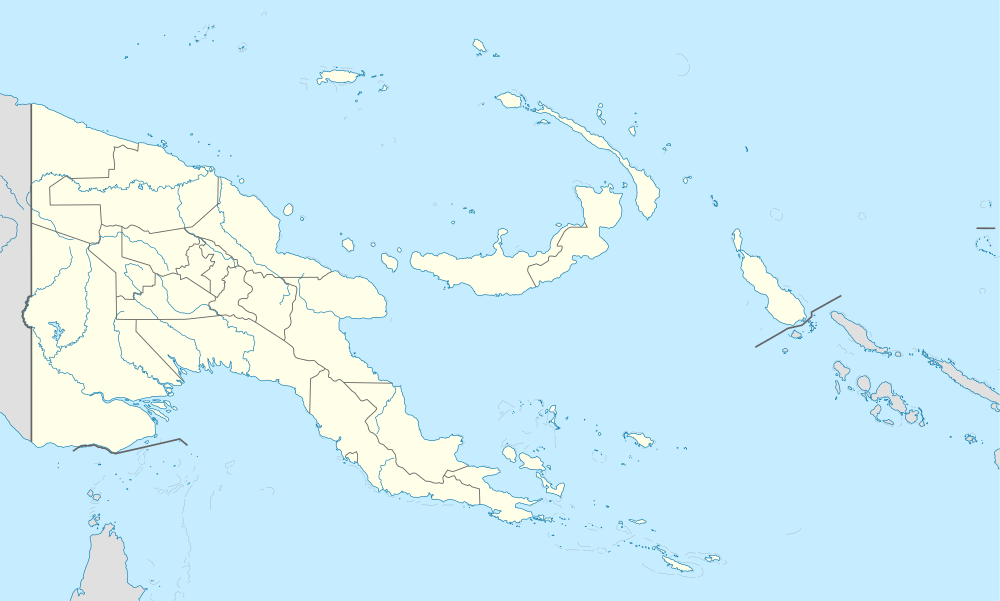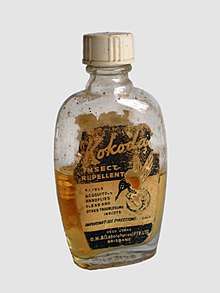Kokoda
Kokoda is a station town in the Oro Province of Papua New Guinea. It is famous as the northern end of the Kokoda Track, site of the eponymous Kokoda Track campaign of World War II. In that campaign, it had strategic significance because it had the only airfield along the Track. In the decades preceding, it had been a foothills settlement near the gold fields.
Kokoda | |
|---|---|
 Kokoda Location within Papua New Guinea | |
| Coordinates: 8°52′40″S 147°44′15″E | |
| Country | Papua New Guinea |
| Province | Oro (Northern) |
| District | Sohe District |
| LLG | Kokoda Rural LLG |
| Elevation | 370 m (1,210 ft) |
| Population (2011), quandl.com | |
| • Total | 658 |
| Languages | |
| • Main languages | Koiari, Motu |
| Time zone | UTC+10 (AEST) |
| Location | 55 km (34 mi) WSW of Popondetta |
| Annual rainfall | 5,000 mm (196.9 in) |
| Climate | Af |
Kokoda is located within the administrative divisions of Kokoda Rural LLG.
Establishment of the station town
Before British colonisation in the late 19th century, the area around Kokoda belonged solely to the Orokaiva people. In 1899 Henry Stuart-Russell was surveying a path from Port Moresby to the north coast of New Guinea. He encountered Orokaiva in the upper reaches of the Kumusi and Mambare Rivers who opposed his presence and his party subsequently shot down numerous people who had the mistaken belief that their shields could deflect bullets. Stuart-Russell also found signs of gold in this area which encouraged British and Anglo-Australian miners to enter the area. The entry of these miners caused further conflict and death on both sides and the British paramilitary force in New Guinea known as the Papuan Native Constabulary (PNC) was ordered to the area to enforce colonial rule. William Armit, the Resident Magistrate of the region, arrived with his troopers killing 17 people in one village and another 24 people in subsequent patrols. He had the aim of preventing the survivors from returning to their villages for 2 years. Armit had previously served as an officer in the brutal Native Police based in Queensland. He died from fever not long after these punitive missions and was said to have used crucified captives for target practice while in New Guinea.
In 1901, after Armit's death, further patrols by the PNC were led by his replacement in Alexander Elliot. Elliot and his troopers shot dead forty Orokaiva and left another 17 with broken legs while avenging the killings of two white miners. Elliot was warned by his superiors not to describe the killing of natives in "sporting parlance", but otherwise his actions were not disapproved of. Further punitive raids were conducted by officers Allen Walsh, Archibald Walker and Richard de Moleyns, killing around 50 natives with their newly issued Martini-Enfield rifles. The British found that a base for the PNC and colonial control was required to subdue the region and the government station of Kokoda was founded in 1904. Government officer Henry Griffin forced local people to become laborers and carriers to construct the town and build roads in the region. If they refused Griffin would order his troopers to shoot their pigs and steal their taro plants. From Kokoda, the British and Anglo-Australian forces subdued the Orokaiva and neighbouring tribes.[1]
World War Two
An amphibious landing by Japanese forces to capture Port Moresby, was frustrated by the Japanese defeat in the Battle of the Coral Sea in May 1942 and postponed indefinitely after the Battle of Midway.[2][3] The Japanese command believed there to be a road leading through the Owen-Stanleys from Kokoda to the south coast.[4] An invasion force was landed on the north coast near Buna and Gona from 21 July 1942. Two battles were fought in and around the village during the opening stages of the Kokoda Track campaign. Kokoda was reoccupied by Australian forces on 2 November 1942, following the Japanese withdrawal back to the north coast.[5]
The station is linked by a rough road and a two-hour journey to the provincial capital of Popondetta.
In August 2009 Kokoda airstrip was the destination for Airlines PNG Flight CG4684 that crashed whilst attempting to land.[6] All 13 people on board were killed in the crash including nine Australian passengers who were due to trek the Kokoda Track, a Japanese passenger and three Papua New Guineans including the two pilots.[6][7]

References
- Nelson, Hank (1976). Black, White and Gold. Canberra: ANU Press.
-
- Bullard, Steven (2007). Japanese Army Operations in the South Pacific Area New Britain and Papua Campaigns, 1942–43. translator. Canberra: Australian War Memorial. p. 57–61. ISBN 978-0-9751904-8-7.CS1 maint: ref=harv (link)
-
- Horner, David (May 1993). "Defending Australia in 1942". The Pacific War 1942. War and Society. Canberra: Department of History, Australian Defence Force Academy. pp. 1–21. ISSN 0729-2473.CS1 maint: ref=harv (link)
- Bullard 2007, pp. 95.
-
- Anderson, Nicholas (2014). To Kokoda. Australian Army Campaigns Series – 14. Sydney, New South Wales: Big Sky Publishing. ISBN 978-1-922132-95-6.CS1 maint: ref=harv (link)
- "No survivors in PNG plane crash". News Online. Australian Broadcasting Corporation. 2009-08-12. Retrieved 2009-08-12.
- "'No survivors' at PNG crash site". BBC News. 12 August 2009.